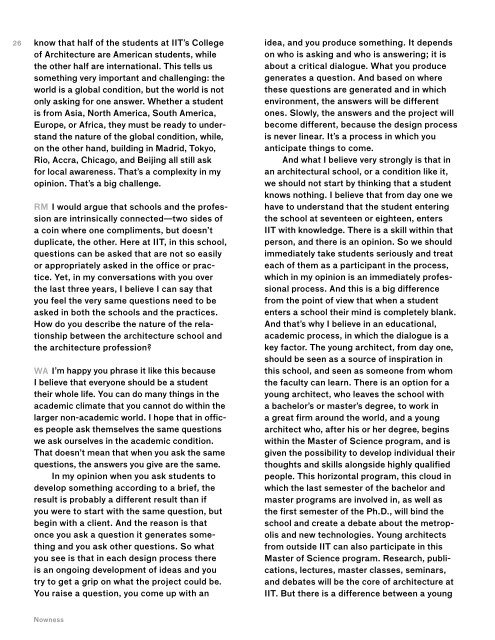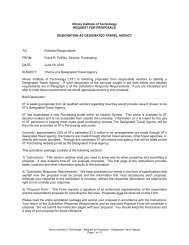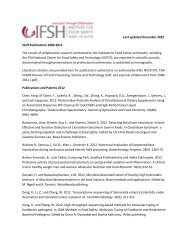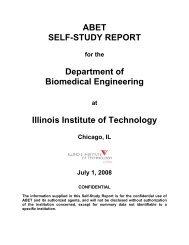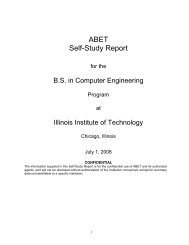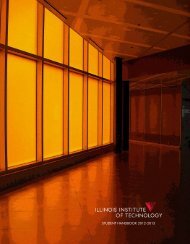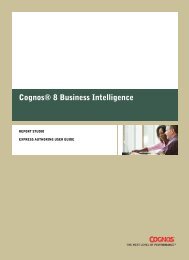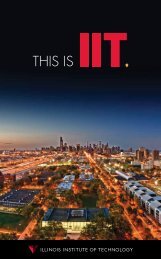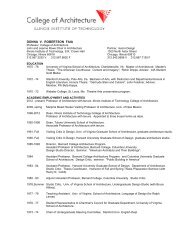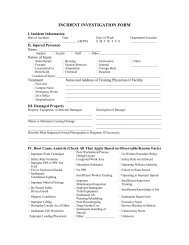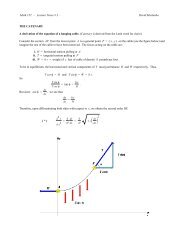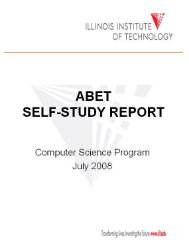Nowness - Illinois Institute of Technology
Nowness - Illinois Institute of Technology
Nowness - Illinois Institute of Technology
You also want an ePaper? Increase the reach of your titles
YUMPU automatically turns print PDFs into web optimized ePapers that Google loves.
know that half <strong>of</strong> the students at IIT’s College<br />
<strong>of</strong> Architecture are American students, while<br />
the other half are international. This tells us<br />
something very important and challenging: the<br />
world is a global condition, but the world is not<br />
only asking for one answer. Whether a student<br />
is from Asia, North America, South America,<br />
Europe, or Africa, they must be ready to understand<br />
the nature <strong>of</strong> the global condition, while,<br />
on the other hand, building in Madrid, Tokyo,<br />
Rio, Accra, Chicago, and Beijing all still ask<br />
for local awareness. That’s a complexity in my<br />
opinion. That’s a big challenge.<br />
student architect and someone who is leaving<br />
the school with a bachelor’s or master’s<br />
degree; the difference is that we have given<br />
the graduate the possibility to develop individual<br />
thoughts and skills alongside highly<br />
qualified people.<br />
26 27<br />
RM I would argue that schools and the pr<strong>of</strong>ession<br />
are intrinsically connected—two sides <strong>of</strong><br />
a coin where one compliments, but doesn’t<br />
duplicate, the other. Here at IIT, in this school,<br />
questions can be asked that are not so easily<br />
or appropriately asked in the <strong>of</strong>fice or practice.<br />
Yet, in my conversations with you over<br />
the last three years, I believe I can say that<br />
you feel the very same questions need to be<br />
asked in both the schools and the practices.<br />
How do you describe the nature <strong>of</strong> the relationship<br />
between the architecture school and<br />
the architecture pr<strong>of</strong>ession?<br />
WA I’m happy you phrase it like this because<br />
I believe that everyone should be a student<br />
their whole life. You can do many things in the<br />
academic climate that you cannot do within the<br />
larger non-academic world. I hope that in <strong>of</strong>fices<br />
people ask themselves the same questions<br />
we ask ourselves in the academic condition.<br />
That doesn’t mean that when you ask the same<br />
questions, the answers you give are the same.<br />
In my opinion when you ask students to<br />
develop something according to a brief, the<br />
result is probably a different result than if<br />
you were to start with the same question, but<br />
begin with a client. And the reason is that<br />
once you ask a question it generates something<br />
and you ask other questions. So what<br />
you see is that in each design process there<br />
is an ongoing development <strong>of</strong> ideas and you<br />
try to get a grip on what the project could be.<br />
You raise a question, you come up with an<br />
idea, and you produce something. It depends<br />
on who is asking and who is answering; it is<br />
about a critical dialogue. What you produce<br />
generates a question. And based on where<br />
these questions are generated and in which<br />
environment, the answers will be different<br />
ones. Slowly, the answers and the project will<br />
become different, because the design process<br />
is never linear. It’s a process in which you<br />
anticipate things to come.<br />
And what I believe very strongly is that in<br />
an architectural school, or a condition like it,<br />
we should not start by thinking that a student<br />
knows nothing. I believe that from day one we<br />
have to understand that the student entering<br />
the school at seventeen or eighteen, enters<br />
IIT with knowledge. There is a skill within that<br />
person, and there is an opinion. So we should<br />
immediately take students seriously and treat<br />
each <strong>of</strong> them as a participant in the process,<br />
which in my opinion is an immediately pr<strong>of</strong>essional<br />
process. And this is a big difference<br />
from the point <strong>of</strong> view that when a student<br />
enters a school their mind is completely blank.<br />
And that’s why I believe in an educational,<br />
academic process, in which the dialogue is a<br />
key factor. The young architect, from day one,<br />
should be seen as a source <strong>of</strong> inspiration in<br />
this school, and seen as someone from whom<br />
the faculty can learn. There is an option for a<br />
young architect, who leaves the school with<br />
a bachelor’s or master’s degree, to work in<br />
a great firm around the world, and a young<br />
architect who, after his or her degree, begins<br />
within the Master <strong>of</strong> Science program, and is<br />
given the possibility to develop individual their<br />
thoughts and skills alongside highly qualified<br />
people. This horizontal program, this cloud in<br />
which the last semester <strong>of</strong> the bachelor and<br />
master programs are involved in, as well as<br />
the first semester <strong>of</strong> the Ph.D., will bind the<br />
school and create a debate about the metropolis<br />
and new technologies. Young architects<br />
from outside IIT can also participate in this<br />
Master <strong>of</strong> Science program. Research, publications,<br />
lectures, master classes, seminars,<br />
and debates will be the core <strong>of</strong> architecture at<br />
IIT. But there is a difference between a young<br />
RM I think what’s implied in your answer to the<br />
question is that schools do not exist because<br />
they already have the answer; they exist as a<br />
place for questions. And I think you’ve always<br />
lead the pr<strong>of</strong>ession through the example<br />
<strong>of</strong> your practice and in a similar way in the<br />
schools, when you set the conceptual theme<br />
for the research studios that you directed<br />
at the Berlage <strong>Institute</strong> in Amsterdam and<br />
Rotterdam. And I think for you a project is a<br />
proposition, a kind <strong>of</strong> provocation for further<br />
thought, and not necessarily the definitive<br />
answer to the original question. Louis Kahn<br />
said, “A good question is much better than<br />
the most brilliant answer. Because the good<br />
question brings you back to the beginnings,<br />
and we all begin to think in our own way.” And<br />
my question is how might a school like IIT be<br />
structured so that it becomes a place where<br />
fundamental questions get asked and not a<br />
place where people come assuming they will<br />
be given the answer?<br />
WA When you understand that the question<br />
is more important than the answer, that the<br />
answer should be raising another question.<br />
As long as the answer raises another relevant<br />
question, the answer is appropriate. What<br />
Mies did was create a situation within which<br />
things were possible. More than ever you<br />
are aware <strong>of</strong> nature when you stand in this<br />
space—Crown Hall. You see what Mies did<br />
with the split between the lower opaque windows<br />
and the windows on top, through which<br />
you look to the sky and to the trees. You see<br />
that this lower opaque surface is a background<br />
for events to occur against. So even when you<br />
work as a student or a teacher in this environment<br />
and look at this lower part, you are never<br />
distracted from things that are happening<br />
outside. And when you are confronted with<br />
something, it is maybe nature or the thing<br />
in front <strong>of</strong> the opaque wall. So what you see<br />
is that the space tries to always be ready<br />
for a new event. It is always ready for things<br />
to happen that are not specific; it is always<br />
generating a new challenge. And that’s a big<br />
difference when compared to a lot <strong>of</strong> architecture,<br />
which is dominant, fixed, and where it’s<br />
extremely difficult to raise a new question or to<br />
feel free to use a space in a different way. And<br />
I think that’s a very generous way <strong>of</strong> dealing<br />
with a condition.<br />
I have the feeling that a student working<br />
in this environment is constantly reminded <strong>of</strong><br />
the fact that—yes—body and mind are <strong>of</strong> great<br />
importance; the environment that you are<br />
working in stimulates you to work in a certain<br />
manner wherein the answer is important as<br />
long as it generates a question. That’s what<br />
our lives are. Every single moment you come<br />
into a new setting. That different conditions<br />
require you to play a certain role within the<br />
public domain is, in my opinion, something we<br />
have to make students aware <strong>of</strong>. We have to<br />
prepare students to rephrase their questions.<br />
When students enter the school we will take<br />
them seriously, but they must be challenged.<br />
This will take place within Crown Hall.<br />
That’s exactly what the Berlage <strong>Institute</strong><br />
did, and that’s exactly what I would like to bring<br />
to IIT. After receiving their B.Arch., students<br />
can be part <strong>of</strong> the Master <strong>of</strong> Science program<br />
at IIT Architecture in which we give young<br />
architects the chance to test their ideas for<br />
a year, while we bring to the school people<br />
working on their thesis or first book or even<br />
first product. I believe that after five years <strong>of</strong><br />
architectural education you can go into an<br />
<strong>of</strong>fice and have the feeling that you are able to<br />
perform and develop in an <strong>of</strong>fice. Or maybe you<br />
spend another year or two in another master’s<br />
program researching and shaping your Ph.D.,<br />
which you can do at this school. During those<br />
years you can formulate your thoughts for the<br />
first time in a more advanced condition. Or in<br />
the Master <strong>of</strong> Science you will be challenged<br />
in an intense way, working full time on studio<br />
work. You can prepare yourself for the “real<br />
<strong>Nowness</strong><br />
<strong>Nowness</strong>


